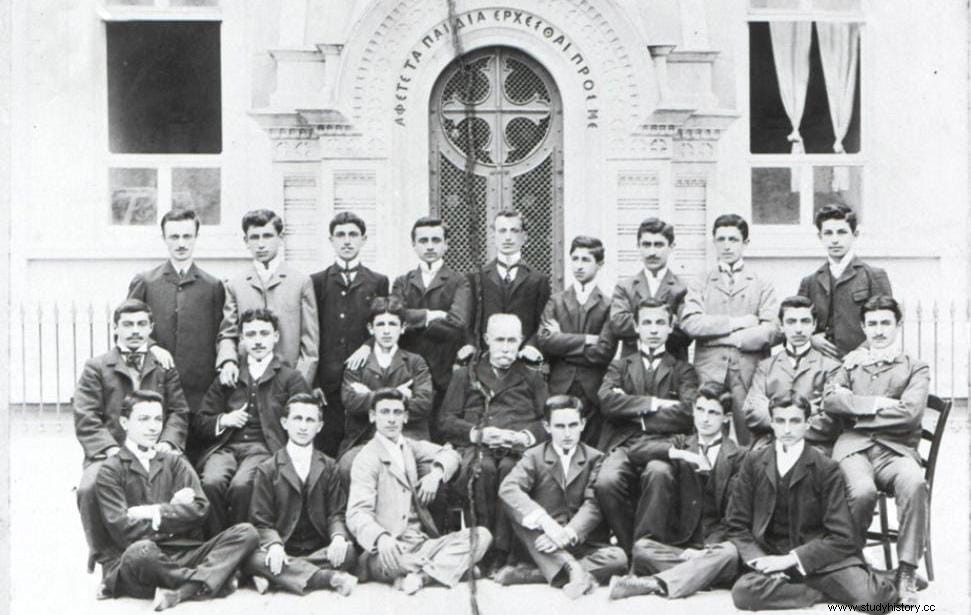When the Ottomans led by Sultan Mehmed II took Constantinople on May 29, 1453, putting an end to the Eastern Roman Empire or Byzantine Empire, they practically controlled all the territories that had formerly been part of it. But a Byzantine Greek state remained independent on the northeast coast of the Anatolian peninsula.
The sea, the sea!
Xenophon recounts in his Anabasis , written around 385 B.C. and where he narrates the return journey of the 10,000 Greek mercenaries who had come to support Cyrus the Younger against his brother, King Artaxerxes II of Persia (among whom was Xenophon himself, who would lead the army on the way back), that the soldiers gave shouts of joy and exclaimed Thalatta! Thalatta! (the sea, the sea!) upon reaching it on the northern coast of Anatolia.
It was not for less after a bumpy retreat route of almost four thousand kilometers through enemy territory. But Xenophon also indicates that the locals understood what the Greeks were saying.
Not only that, but they too were Greeks and had been living there for at least 300 years.
Indeed, it was the Greek colony of Trapezunte, founded by settlers from Miletus or Sinope in 756 BC. on the Black Sea coast, east of present-day Turkey.

Pontic Greeks
The Greeks who inhabited that region are known as Pontic Greeks . They kept their culture and language (the Pontic Greek ), a form of Greek that evolved differently from the current one, given the remoteness and isolation of the territory, practically until today.
After the Ottoman conquest they emigrated to Russia, Georgia, Crimea and other places in several waves, until practically disappearing from the region in 1922 after more than 2,500 years of uninterrupted presence. Today the exact number of Pontic Greeks is unknown. scattered around the world, but only in Greece there are about 2 million.

But much earlier, in 1204, they had founded their own kingdom, the Empire of Trebizond.
Empire of Trebizond
The city of Trapezunte to which Xenophon's mercenaries arrived was renamed Trapezus in Roman times, and later Trebizond during Byzantine rule (today the Turks call it Trabzon).
In the year 1185, the overthrow and death of the last Byzantine emperor of the Komnenos dynasty, Andronicus I, caused his family to flee. Two of his grandchildren, Alexius and David, took refuge in Georgia, at the court of Queen Tamar. With her help they conquered Trebizond in April 1204, and then the entire coastal strip occupying Sinope, Paflagonia and Heracleia Pontica.
Alexios proclaimed himself emperor and established his capital at Trebizond. The new empire of Trebizond prospered and came to control territories in the Crimea in the late 13th century. But the Muslim advance in Anatolia meant that it remained isolated from the other Greek states for practically its entire existence.

Thus, they supported Tamerlane when he faced and defeated the Ottoman sultan Beyazid I at the Battle of Ankara on July 20, 1402, even providing him with some ships.
They withstood an Ottoman attack by sea in 1442, and when Sultan Mehmed II took Constantinople on May 29, 1453, ending the Eastern Roman Empire, Trebizond asked France for help, which ignored them, and had to rely on the Ak Koyunlu or White Sheep Turkmen , with whose leaders the Byzantine princesses of Trebizond married.

These Ak Koyunlu were a federation of Oguz Turks and Sunni Muslim religion, enemies of the Ottomans, against whom they would later ally with Venice and the Order of the Knights of Rhodes.
The Empire of Trebizond would thus be able to endure eight years after the fall of Constantinople. In 1461 Mehmed II besieged the city for 21 days, after which Emperor David capitulated on the condition that the lives of the citizens be respected and that anyone who wishes be allowed to leave the city.
Mehmed did not comply and the city was sacked. The Empire of Trebizond was the last Byzantine Greek state to fall under Ottoman rule, 24 emperors and 257 years after it was founded.

The Ottomans would still take another 18 years to definitively eliminate the Greek resistance in Pontus. During this time many Pontic Greek nobles and aristocrats intermarried with emperors and kings of foreign dynasties, notably from Russia, Georgia, and Persia, in order to obtain protection and help against the Ottoman threat.
Many families of all kinds adopted the Turkish language and Islam, but often remained Crypto-Christian before reverting to Greek Orthodoxy in the early 19th century.
The Republic of Pontus
There were thus still Pontic Greeks in Trebizond when the victorious allies of the First World War met at the Paris Peace Conference in 1919 to agree on the terms of the armistice with the defeated Central Powers (Germany, the Ottoman Empire, Bulgaria, Austria and Hungary). ).

There the creation of a new Greek state was proposed in Trebizond, independent of Turkey but also of Greece, the Republic of Pontus. The new state was to include much of the northeastern Black Sea region of present-day Turkey.
However, the Prime Minister of Greece, Eleftherios Venizelos, expressed in Paris his fear that an independent Republic of Pontus would be too far away to receive military assistance from Greece, and would be too weak to defend against a Turkish attack.
For this reason, the proposal did not prosper and what could have been a revival of the Byzantine Greek Trebizond came to nothing.
